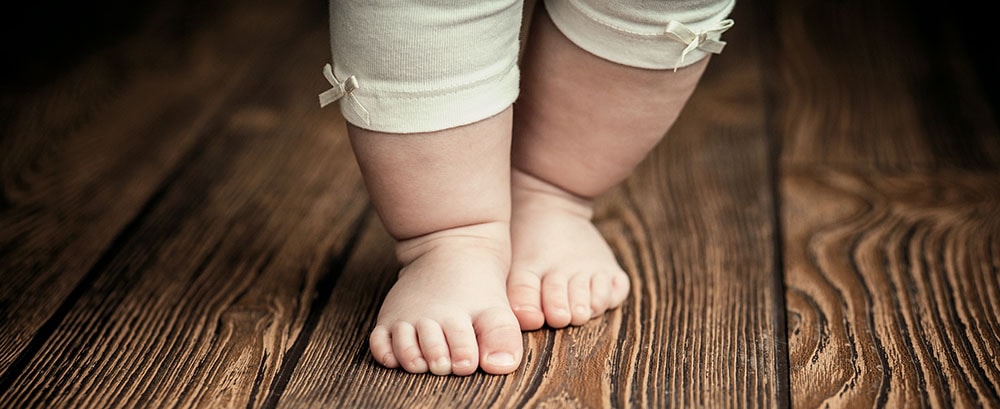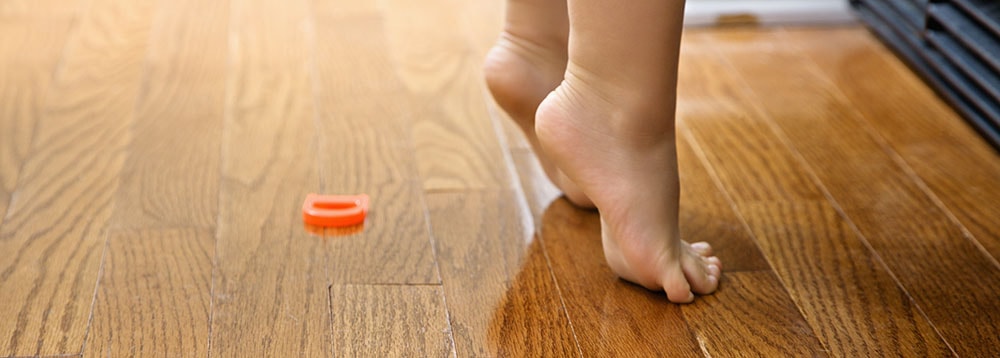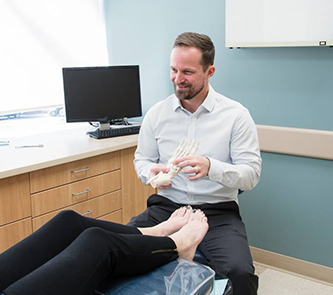Child Foot Care Tips: Advice Every Parent Needs [Complete Guide]
Parents all over the world have at least one thing in common – above anything else, you simply want your children to be happy and healthy.
In all likelihood, you probably don’t give this a lot of thought, but a child’s feet play an instrumental role in both happiness and health! Since that’s the case, one of our goals is to give you the tools you need to keep your children’s feet safe.
(Whereas you can always bring your son or daughter to see us for gentle care in addressing pediatric foot and ankle problems, we’ll bet you’d prefer to know your children didn’t experience a painful condition in the first place!)
Now, between the two states—happiness and health—it’s probably easier to see how child foot care can impact health. After all, following the right measures can lower the odds that a child will develop issues like blisters, plantar warts, and ingrown toenails.
With health being an easily understandable benefit of foot safety and care, how does a child’s happiness relate?
Well, let’s start by taking a moment to consider activities children enjoy doing – and particularly ones that don’t entail staring at a screen.
If you stop to think about it, there’s a decent chance you will think about kids at play – running around during either their own, made-up games or in organized sporting activities. Whether or not you’re already aware of this, play is actually an essential part of human development during our younger years.
Of course, it’s rather difficult to be active and run around when foot issues are in the picture, especially when they cause pain and discomfort.
This all probably makes a lot of sense and leads to the inevitable question – so how you can you protect a child’s feet?
Tips for Optimal Child Foot Health

There are certain measures you can take to keep a son’s or daughter’s feet healthy and on an appropriate developmental track. The good news is that these measures aren’t terribly difficult and include things like:
- Provide proper footwear. It is difficult to overstate the importance of proper shoes for foot health. This means footwear that is both activity-appropriate and fit correctly.
On the “activity-appropriate” front, your daughter should play soccer in soccer flats (not basketball shoes) and your son should wear basketball shoes on the court (not running shoes), etc.
Regarding fit, buy shoes from a brick-and-mortar store (not online) so you can see how they actually work with your child’s feet. That’s important because footwear should be neither too small nor too big. As a general rule, there should be roughly a thumb’s width of space between the longest toe and front of the shoe and you can slide your finger down the back to about the second knuckle when it’s laced. The heel should be firmly cradled—so the foot isn’t able to slide around inside—and your child should be able to wiggle his or her toes.
The fact of the matter is this – children’s feet grow rather quickly. (They have to in order to support the growing body.) And that means you may have to buy your son or daughter a couple of different pairs throughout the year, especially during early stages of development.
- Keeping feet clean. We know that cleanliness can be the ultimate battle with some children (at least, until the teen years initiate an inevitable struggle for independence…), but it’s one you need to win. In this case, victory means making sure they wash their feet every day.
Why is that important? Well, fungal and bacterial infections aren’t usually common problems in early years, but establishing this practice early will reduce their risk for fungal toenails and athlete’s foot later on. At the same time, proper hygiene is just always a good practice!
- Start a regular stretching routine. When we look at the lower limbs and problems that can develop, some are caused by tissues—particularly the Achilles tendon and calf muscle—that are excessively tight. To help your children prevent injuries, walk them through a daily stretching routine. This doesn’t have to be terribly extensive – even around five minutes a day can make a big difference. (Even better, this habit will pay dividends as they get older!)
- Give them nutritious food. Okay, out of the many different health-related reasons you can think of for doing this, foot health probably isn’t near the top of the list. However, the fact of the matter is this – feet can stay strong and healthy when they receive essential nutrients. Protein is important for muscle health and calcium and vitamin D contribute to bone strength.
Those key blocks of the musculoskeletal system are clearly important, but a well-balanced diet also plays a role in weight management. Whereas stronger feet can better support heavier weight loads, it’s simply better for them not to need to absorb excessive amounts of force in the first place.
- Keep toenails trimmed – the right way. Keeping a child’s toenails clipped at an appropriate length is a good starting point in lowering the odds for ingrown nails, but it’s also important to make sure an appropriate technique is being followed as well.
In this case, we mean to make sure you cut your child’s nails—and ultimately teach them to do so on their own—so they are A) roughly even with the edges of their respective toes and B) straight across (instead of rounded, as people often do with fingernails).
Understanding Common Child Foot Issues

As with most demographical segments, children have a higher risk for certain conditions and problems than other ones. We’ve already touched on the fact that it can be rare for a child to have a case of fungal toenails, but ones that do tend to be more common include:
- Sports injuries. Something else that’s already been touched upon (even if briefly) is how important physical activity and sports can be for child development. Children are supposed to be active, but a body in motion is always going to have at least a certain degree of injury risk (even when taking measures to minimize that risk). Foot and ankle injuries tend to be especially common, which is unsurprising when we consider how often they are used in athletic activities.
When a child hurts a foot or ankle, it’s helpful to apply basic first aid measures (such as RICE) as soon as possible for most cases. If you’re unfamiliar, RICE is an acronym standing for “rest, ice, compression, elevation.” These four components are used to prevent further injury, control swelling, and relieve pain from an injury.
If you have a son or daughter who sustains a more serious injury—such as a broken bone in a foot or ankle—professional care will be needed.
- Plantar warts. Part of typical child nature is curiosity – which serves to help develop young minds. At the same time, curiosity can be the reason a child touches a friend’s wart. In doing so, he or she may pick up the virus responsible for the wart (human papillomavirus, also known as HPV).
You have probably heard about HPV in different contexts than this, but the virus has many different strands (more than 100), and some cause warts. An interesting thing is that the same strand that causes a wart to grow for one person might not do the same for the next, even if the two are related.
There are other ways kids contract plantar warts, of course. No matter the root cause, a wart on the bottom of the foot can be painful and cause discomfort when walking or standing.
You’ve probably seen at-home wart removal kits at the store, but those products have questionable results. They are usually either too strong or not strong enough – thereby damaging healthy skin or not resolving the problem. If your son or daughter has this problem, bring your child in for an appointment and we will provide professional treatment.
- Ingrown toenails. This is a condition that happens to people of all ages – everyone from 2-months-old infants to seniors crossing the century mark can have a nail become ingrown. We did note one particular method for lowering risk (proper nail trimming), but some cases are unpreventable. Whereas toenail trimming and tight footwear can be to blame, so can physical trauma and genetics, both of which are difficult-to-impossible to prevent.
When a child has pain from an ingrown toenail, you may want to attempt handling the problem at home with medication (to relieve the pain) and then soaking the affected foot. Once the nail has softened, you can then attempt to lift the ingrown edge up and placing a bit of clean, waxed dental floss underneath so it grows over (and not into) the skin.
Perhaps a better approach is to simply bring your son or daughter into our office for gentle, professional care.
To Worry or Not To Worry – Now, That’s the Question!

There are a couple of structural issues parents observe in children’s feet and start to worry about. Not all of these cases are worth the worry, though. These issues include:
- Intoeing/out-toeing. In these respective conditions, feet either point inward or outward. Many are caused by abnormal twisting of either the upper or lower leg points, but some cases of intoeing are related to curvature within affected feet themselves.
There is generally not a lot of reason to worry about intoeing. The vast majority of cases will resolve on their own as bones grow and strengthen. Out-toeing is a bit more concerning than that, but there are treatment options that can be quite beneficial.
Either way, the good news is that the odds are pretty low (although, they aren’t nonexistent) the condition is painful for your son or daughter or will lead to long-term difficulty.
- Flat Feet. Another source of concern for parents is seeing that a child’s feet are flat. The reason this shouldn’t be terribly worrying is the fact that pediatric flatfoot is sometimes a simple matter of normal foot development.
In early stages, foot arches are obscured by pads of fat. Additionally, a child can hit age 3 without his or her arches really starting to develop. Since they continue to do so until around the age of 8, your child might have what is known as “pediatric flexible flatfoot.”
A big reason this condition shouldn’t be much of a worry is the fact a flatfoot condition will usually only need to be treated if it causes pain or leads to faulty foot biomechanics. Even then, a pair of custom orthotics can work wonders in addressing the problem.
- Sever’s disease. The leading cause of heel pain for adults is plantar fasciitis. For adolescents, most heel pain is the result of this particular condition.
In spite of the name, Sever’s is not a disease. Rather, it is a “growing pain” situation caused by differences in growth rates for the heel bone and Achilles tendon (which is anchored to it). Given this fact, our treatment is centered on relieving symptoms so your son or daughter can comfortably participate in normal and favorite activities. There is no need to “correct” the condition, since it will usually resolve on its own in time, and without causing any long-term issues.
Professional Child Foot Care in Portsmouth
If you would like more information on child foot care—or have a son or daughter who is suffering from foot pain or dysfunction—give us a call at (603) 431-6070 and we’ll be glad to help. While on the phone, you can ask any questions or request an appointment with either our Portsmouth or Nashua offices!
Pay Your Bill
Make a payment online through our payment portal or Care Credit!
Portsmouth Office
14 Manchester Square, Suite 250
Portsmouth, NH 03801
Nashua Office
17 Riverside Street, Suite 205
Nashua, NH 03062
Website Hosted by SC Digital



